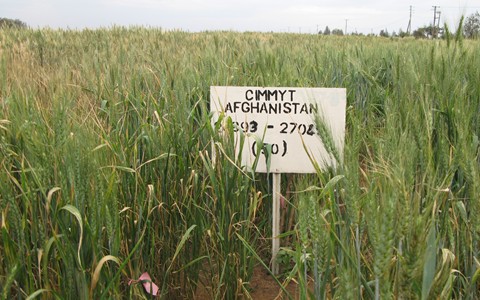
It took over half-a-year, but the Wired piece that brought us out to Kenya last fall is finally live. It’s the tale of a wheat-killing fungus called Ug99, which is currently sweeping across Central Asia. The pathogen is remarkable because it can easily overcomes the genetic defenses created by the Green Revolution. As a result, the vast majority of the world’s wheat is susceptible to Ug99, and a major catastrophe could ensue if nothing is done to halt the epidemic’s spread.
We’ll be posting bonus material all week, so fear not—your Ug99 jones shall be sated. For the moment, though, we’re just going to point you toward one of the most interesting aspects of the article: the tale of the man who discovered Ug99, a Ugandan wheat breeder named William Wagoire. When news broke of the pathogen’s presence in southern Uganda, Wagoire should have been celebrated as a scientific hero. Instead, he was villified:
Uganda’s tabloid press jumped on the story. Kampala newspapers manipulated the facts to demonize Wagoire, making it appear as though he had somehow synthesized Ug99 in a lab. Accustomed to hearing tales of how Western scientists had invented HIV, the Ugandan public was all too willing to swallow the sci-fi narrative. “The local politicians and the general populace, they do not know about the evolution of diseases,” Wagoire says. “All they know is that research scientists work in laboratories and that diseases are in laboratories. So in this case, the story was ‘Wagoire has created a disease which is going to wipe out all the wheat in the world!’ That was a very trying time for me.”
We do, of course, urge you to read the whole thing, then help spread the word. Erokamano, dear readers.
(Image by Microkhan. It’s a photo we snapped of Afghanistan’s “test wheat,” planted at Njoro, Kenya, where Ug99 is in the wild.)


Bobby // Feb 23, 2010 at 9:03 pm
Hey Brendan,
I’ve been wondering for a while now what this was all about–it’s terrific! Nice work.
Bobby
Brendan I. Koerner // Feb 23, 2010 at 9:30 pm
@Bobby: Thanks a million, man. Put a lot of work into that piece, esp. considering that I knew absolutely zero ’bout plant pathogens before launching into the reporting. Good to hear it came out okay.
Captured Shadow // Feb 24, 2010 at 5:26 pm
Nice work on this one. Reminds me of “The Coming Plague”, but in a nice magazine length.
Brendan I. Koerner // Feb 24, 2010 at 6:00 pm
@Captured Shadow: Cool, thanks for the read. Glad you dug it.
Gotta give Wired some major love for letting me tackle the piece. Fungi are outside the mag’s normal wheelhouse, but they never hesitated for a second. Sometimes I forget how lucky I am.
BTW, last time I checked, the Ug99 piece had been tweeted about a grand total of 17 times. My essay on the productivity benefits of social media, by contrast, had been tweeted 1,100 times and counting. There’s a lesson in there somewhere…
Andy R. // Feb 25, 2010 at 11:44 am
Loved the piece! I grew up farming wheat in Kansas and my dad still runs a couple thousand acres of crop ground in production.
Surprises me that this is the first I had read on the fungus.
Once again, good work on this an many other articles. You are one of the main reasons I subscribe to WIRED.
Andy
Brendan I. Koerner // Feb 25, 2010 at 1:48 pm
@Andy: Wow, thank you. I’m glad the piece passed muster with a genuine farmer. Here in NYC, I’m pretty disconnected from those who till the land–which, in part, is why this topic appealed to me so much.
I’ll be sure to cite your comment when it’s time to ask WIRED for a raise.